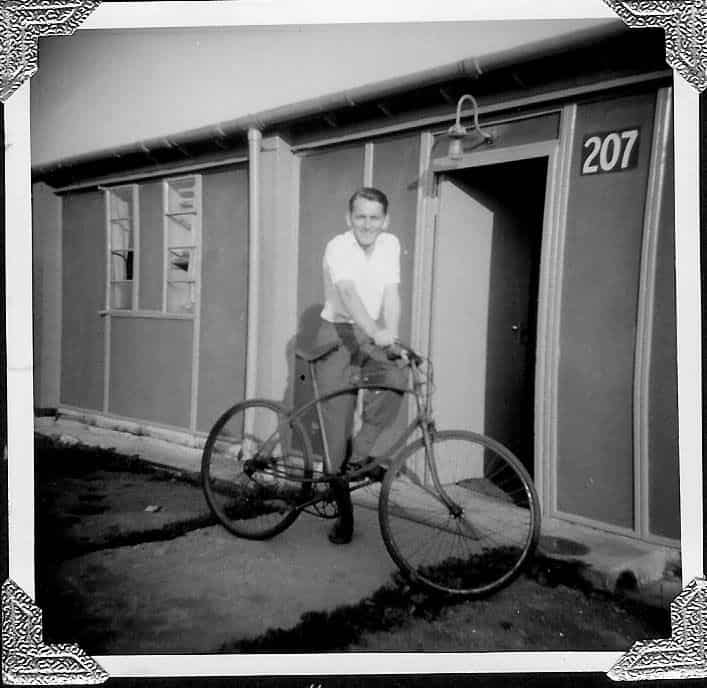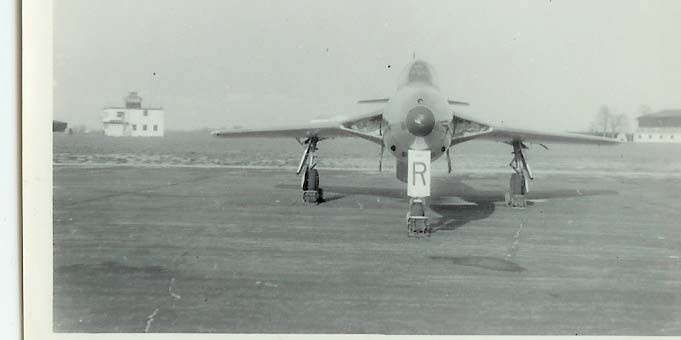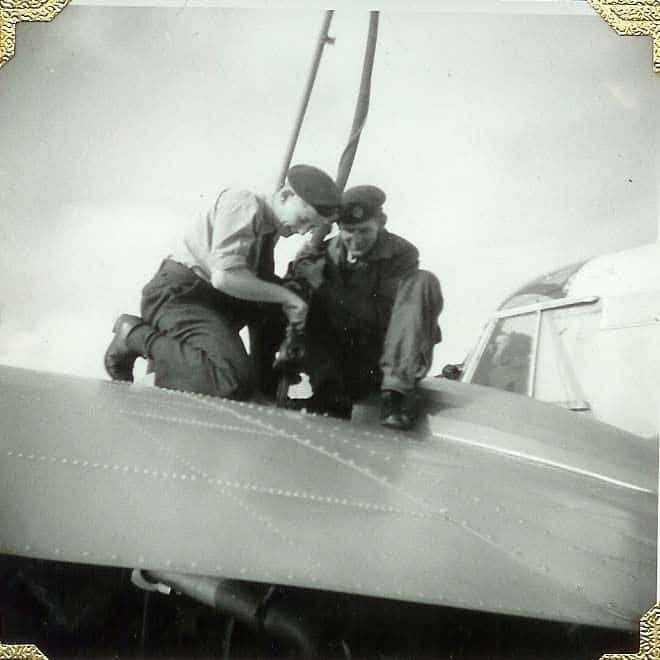





After a few weeks I discovered there was the occasional opportunity to get a flight in a Meteor T3 and so I mentioned to Bob Ridley that if the chance arose I would not mind a flight. A few weeks later he came up to me and told me to report to the flight crew office, as there was a trip available. I eagerly arrived there to be fitted out with an overall and a parachute. When we arrived at the plane there were my grinning friends enquiring if I needed spew bags, which I declined, whereupon the pilot shoved them in my hand and said “ Take em !” The pilot was our flight commander who was keeping up his hours. The pilots had to do so many hours per month to continue flying. It was my first trip in a jet plane particularly a jetfighter even if it was only a trainer. When he opened up the throttle it was as if a big hand was pushing in the middle of my back as we hurtled down the runway. He pulled back on the joystick and we went up near vertical. He levelled out at 10,000 feet, as I could not go above that height even though we had oxygen. I later learned you could not go above 10,000 feet without first having a decompression test in a decompression chamber. Well he stooged about for something like 30 minutes at one time going into a dive then pulling up into a climb, it was all very exhilarating and came to end far too quickly for me. Fortunately I did not need the spew bags. It was my only flight whilst at Merryfield as they were very much in demand. Some people did need the spew bags, I remember one occasion when a rather bumptious corporal from one of the administration offices got himself a flight and when asked to take spew bags scornfully threw them a side. When they returned a colleague of mine Bruce Garner opened the canopy to see this rather green faced corporal who then proceeded to hand him a glove with an evil smell coming from it. Bruce recoiled from the offer and told him in no uncertain terms to get rid of it himself and to come back to clean up the mess in the cockpit. It turned out that with the pilot doing a few manoeuvres the corporal felt rather ill and the only thing available to be sick in was one of the pilot’s gloves about which he was not amused.
A further point relating to my flight in a meteor came from reading a piece out of the web page by Ralph Swift on Jet training at Merryfield. He told of the difficulty of getting out of a Vampire prior to having ejection seats. I remember when I was about to climb into the back seat of the Meteor trainer the pilot gave me one or two details which he felt I ought to know about. He ended this by saying "Oh! By the way if we have to get out you need to do the following". I will jettison the canopy. You then can unfasten your seat harness stand up on the seat and then dive over the side so that you miss the tail plane. Got that! I timidly replied "Yes Sir". Reflecting on this required course of action, the thought of trying to do all of that with the aircraft probably out of control with it either diving or spinning or possibly both, the prospect even today scares the pants off me. Yet on the day with the excitment of the moment I never gave it a second thought.
Being a small squadron we did all the work on the aircraft. This fell into two categories, first and second line servicing, there was a third line servicing which usually meant the aircraft going to an MU Maintenance Unit such as RAF St Athan, near Cardiff. First line servicing was done every time an aircraft flew which consisted of a number of checks on the airframe, tyres, pneumatics and hydraulics and securing or setting the ejection seat ready for activation. This consisted of fitting or removing a safety pin. If the aircraft flew or not they were serviced every 72 hours which usually consisted of a more intensive check in particular running the engines. We also were required to marshal the aircraft on leaving for a sortie and again on their return. Marshalling consisted of making sure the plane was clear of all obstacles as he left the parking area out to the perimeter track where it became the responsibility of the pilot. On his return someone would stand out on the perimeter track to indicate where the pilot had to exit for the parking area. A second guy would stand at the place where the plane was to be parked, he would wait until the first guy handed over to him and he would then stand with his arms held out to form a letter Y. He would then manoeuvre the pilot to the required parking spot by moving his left arm to tell him to go left or the right arm to go right, both arms moving in unison backwards and forwards towards the body meant come forward in a straight line. The steering of a Meteor consisted of the pilot operating his foot brakes on the rudder pedals. It was the only time you could tell the pilot what to do. There could be moments of excitement such as if you had a novice pilot fresh from flying training. If the pilot did not get the engine start procedure quite right you would have what was known as a “wet start “. If you had one of these the procedure was to run the engine cold to blow out the excess fuel and retry. However some bright sparks would press the re-light button on the throttle which if it worked usually created a flame with a loud whoosh out of the rear end of the jet pipe. If and when this happened to a novice pilot the expression on their faces was a picture as they were fastened in and it looked as if the plane was about to go up in smoke.
In the January I arrived we had some particularly bad weather were the airfield was covered with snow for several days and the aircraft were not even taken out of the hangar which was usually done irrespective of whether they flew. We sat in the ground crew room trying to keep warm and waiting for the NAFFI wagon to arrive. The NAFFI wagon was a regular event in the lives of the ground crew coming each morning and afternoon. The one at Merryfield sold a variety of things the two main things I remember being buttered crusty cobs which we used to stuff with crisps and a Cornish Pasty called a “ Tiddy Oggi “ all washed down with a mug of strong dark tea. (A taste for this type of tea never left me through many hours on sites where such tea is always brewed.)
In the Summer it was very pleasant out on the airfield in that we would sunbathe while waiting for the planes to return. At times there would be a distraction in that there was a hangar on the other side of the airfield which was occupied by a test flight from Westland and they had a Canberra which would go off on a test flight some days. On it’s return the pilot would occasionally beat up the airfield. He would come in very, very low and as he came to the centre of the airfield would just go up vertically or on other occasions do a roll across the airfield. Everyone would give him a cheer and a wave in appreciation as he taxied past following his landing.

One Canberra we had on the flight was the one used in the London to Christchurch, New Zealand air race in 1953. It was painted PR blue and had printed on its nose London to Christchurch 23 hours 34 minutes. The Canberra is now in the RAF museum at Hendon.
Our Commanding Officer was a Wing Commander who we were convinced was trying to get Group Captain in that he had a parade every Saturday morning. You were only excused the parade if you were on other duties or had been on night flying the night before. So most Friday nights were spent bulling your kit ready for the parade next morning. It was only after the parade was over that we could leave for our weekend pass.
In the 10 months I was at Merryfield I am pretty sure I got home every weekend, somehow miraculously avoiding guard or fire picket duties. There was about 5 or 6 of us who travelled regularly to Birmingham and back. Early in the year we travelled mainly by train but later on one of the guys, Nobby Clarke, bought a car.



A flight of fancy with me in the Anson.
Not long after this we learned that the Royal Navy was to take over at Merryfield while work was carried out on the runway at RNAS Yeovilton for the delivery of Sea Vixens. The squadron was to move to RAF Wyton near Huntingdon. However I took the opportunity to ask for a posting nearer to home and after two weeks of being attached to the Navy I was posted to RAF Gaydon near Leamington Spa.
In 2002 I was working as a clerk to a school inspection team when I visited a school in Devon. On the way home along the M5 I made a detour at Taunton to find the village of Ilton just to see what had changed in the ensuing years. The village did not appear much different except that there were new houses and bungalows about. The pub and village shop were still the same and then I noticed the lane which used to lead to the airfield. I drove down the lane and saw a small industrial estate, just past this I saw what used to be the entrance to the airfield and where the guard doom had been, all now gone, there was a rickety fence across the entrance. I decided to drive on further to where the end of the runway used to be so I could look across the airfield. As I went round a bend there in front of me was an entrance with a notice saying “Royal Naval Air Station Merryfield”. I was amazed that after all those years it was still an operational station. I drove in and there was barrier and a small security hut out of which emerged a security guy. He asked what I wanted and I told him that I had been stationed there in 1955. Being some 30 or 40 years younger than me he looked at me with an expression of great surprise but with a deal of pleasure. He told me it was a pity but the CO was away as he would have liked to have met me as he always wished to meet anyone associated with Merryfield. The station now operated as a satellite of RNAS Yeovilton and there were helicopters practising take-off and landings. We chatted for some time about the airfield and what had happened over the years. I came away quite pleased to think it was still in use.
